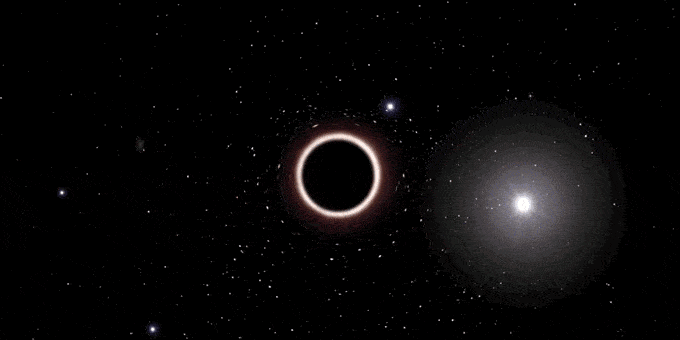
Physicists in Israel have devised a black hole analogue — only, rather than being a gravitational fortex that doesn’t allow light to escape, this particular object is a sonic black hole that doesn’t allow sound waves to escape. In the process, the researchers measured the long-theorized Hawking radiation, with important consequences for physics.
A black hole is a region of spacetime where gravity pulls so strongly that even light cannot get out once it crosses a point of no return, known as the event horizon — but you probably knew that already. What may be new to you is that almost 50 years ago, Stephen Hawking proposed a more nuanced view whereby black holes can also generate light.
According to Hawking, black holes can spontaneously emit photons at the event horizon thanks to transient quantum fluctuations known as virtual particles. Despite their name, virtual particles are indeed real particles — it’s just that they pop in and out of existence for a fleeting time.
Virtual particles appear in pairs and in the vast majority of cases they annihilate each other almost immediately. However, if they appear in the vicinity of a black hole, Hawking suggested that it is possible for one particle in a pair to get absorbed by the black hole, while the other escapes into space.
This stream of particles is known as stationary Hawking radiation, but since this phenomenon is so subtle, it’s virtually impossible for our instruments to detect it. But, with some thinking outside the box, it is possible to gain insight into this elusive cosmic phenomenon.
In order to study Hawking radiation, scientists from Technion-Israel Institute of Technology designed a scaled-down version of a black hole, or analogue, in the lab. An example of a black hole analogue can be found in your very own home: a bathtub vortex. The water swirling down the drain can be compared to black hole accretion of matter — but this isn’t what the physicists in Israel used.
Instead, the team cooled down 8,000 rubidium atoms to nearly absolute zero and trapped them in place with a laser beam. This nearly static gas was in an exotic state of matter known as Bose-Einstein Condensate (BEC), in which atoms become so densely packed they behave like one super atom, acting in unison.
A second laser beam created a stream of potential energy that caused the BEC gas to flow like water rushing down a waterfall. The boundary between the region where one half of the gas was flowing faster than the speed of sound while the other half flowed slowly was the event horizon of the sonic black hole.
Rather than pairs of photons spontaneously forming in the gas, the researchers were looking for pairs of phonons — quantum sound wave particles. Phonons in the faster half of the gas flow, beyond the event horizon, are trapped by the speed of the flowing gas. Just like in a black hole that has trapped light particles crossing the event horizon, the phonon cannot return to the other side of the sonic black hole’s event horizon.
“Essentially, the event horizon is a black hole’s outer sphere, and inside it, there’s a small sphere called the inner horizon,” Prof. Jeff Steinhauer of Technion’s Physics Department said in a statement. “If you fall through the inner horizon, then you’re still stuck in the black hole, but at least you don’t feel the weird physics of being in a black hole. You’d be in a more ‘normal’ environment, as the pull of gravity would be lower, so you wouldn’t feel it anymore.”

It took 97,000 iterations of this experiment over 124 consecutive days for the physicists led by Steinhauer to confirm Hawking radiation. Luckily for them, their patience paid off.
“The experimental results of Prof. Steinhauer are of great importance and interest,” Prof. Amos Ori, a general relativity and black hole expert at the Technion Physics Department, said in a statement.
“Jeff measures stationary Hawking radiation emitted from a sonic black hole, in agreement with Hawking’s theoretical prediction. This gives very significant experimental support to Hawking’s analysis, which gets experimental approval for the first time in Jeff’s experiments.”
The experiments also revealed new insights that weren’t predicted during Hawking’s lifetime. After a certain time, the radiation emitted by the system began to intensify. This is likely due to the development of stimulated radiation following the formation of the inner horizon, the physicists explained in the journal Nature Physics.
“Our new long-term goal,” Steinhauer concluded, “is to see what happens when one goes beyond the approximations used by Hawking, in which the Hawking radiation is quantum, but space-time is classical. In other words, we would take into account that the analogue black hole is composed of point-like atoms.”





